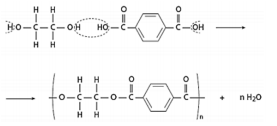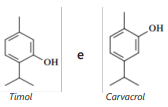Questões de Vestibular UFRR 2016 para Vestibular
Foram encontradas 72 questões
Observe a seguinte reação de polimerização entre o etilenoglicol e o ácido tereftálico:

O nome da reação de polimerização acima, o nome do
polímero obtido e a função orgânica presente nele são
respectivamente:
Leia as informações sobre os pares de compostos:

O timol é encontrado abundantemente no óleo essencial do “alecrim-pimenta”, um exemplar típico do Nordeste brasileiro. O carvacrol possui característica pungente e odor aromático, semelhante ao orégano.
 e
e 
Neral Geranial
O Lemonal (Citral), um aldeído com forte cheiro de limão, encontrado em óleos essenciais de capim-limão, erva cidereira, citronela, etc. é formado por uma mistura de aldeídos como o Neral e o Geranial.
 e
e 
Pseudoefedrina Efedrina
A Pseudoefedrina é um antialérgico de uso oral muito utilizado no tratamento de sintomas associados à rinite alérgica, gripes e resfriados, como coriza, coceira, entupimento do nariz ou lacrimejamento excessivo. Igualmente como a Efedrina pode ser encontrado na composição de certos vegetais como a Ephedra vulgaris (nome científico) e Cipó-de-areia (nome popular).
Com relação a todas as estruturas mostradas acima, são feitas as seguintes afirmações:
I - O Neral e o Geranial são isômeros geométricos. O Geranial é o isômero trans ou E (entegen) e Neral é o isômero cis ou Z (zusammen).
II - O Timol e o Carvacrol são isômeros de cadeia.
III - Tanto o Neral como o Geranial podem ser obtidos por oxidação branda do Nerol e Geraniol.
IV - A Pseudoefedrina e Efedrina são isômeros ópticos e possuem fórmula molecular C10H15NO.
V - Tanto o Neral quanto o Geranial, cujas estruturas foram aqui apresentadas possuem fórmula molecular C9 H15O.
VI - Tanto o Timol quanto o Carvacrol podem sofrer reações de substituição eletrofílica.
Sobre as afirmativas acima podemos dizer que: